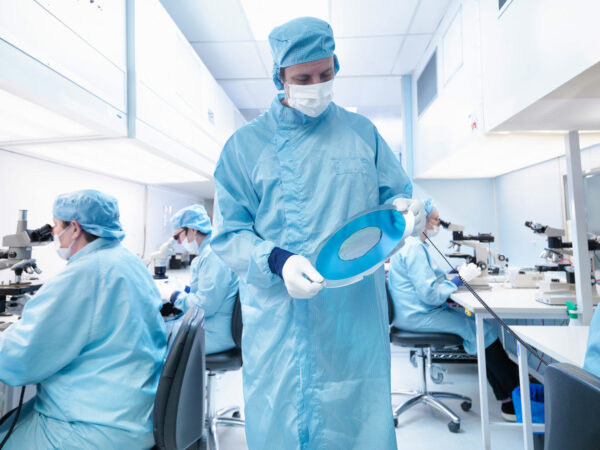Reinventing
the Wheel
Product engineering processes are undergoing profound change. Companies are having to manage ever greater levels of complexity and strategically rethink established development principles. A focus on systemic processes has already been applied to cars, enabling them to be developed and produced more efficiently and brought onto markets more rapidly. The basic principle is universal, however — and therefore applicable to other industries as well.
06/2022

Major automobile manufacturers are undergoing what could be the greatest transformation in their history. Previously viewed strictly as carmakers and loved by their fans for the individual features of their products, they are turning into providers of comprehensive mobility strategies. New markets are arising around fields such as electric mobility, autonomous driving, digitalization, and connectivity. Carmakers are therefore rethinking their entire product creation processes in unprecedented ways. Their aim is no less than to “reinvent the wheel.”
For this tremendous transformation to succeed, a cultural transformation is needed as well. Old silos have to be dismantled and new ways of thinking and working introduced in far-sighted ways. Making cars is no longer sufficient on its own. Instead, developers have to integrate entire mobile ecosystems—including new charging technologies for electric vehicles, the interplay of different mobile devices, and cutting-edge, smart customer services.
Point of no return
What customers want is for their cars to be thoroughly connected with their surroundings.
This new approach is irreversible, because the whole point is to master the increasing levels of technological complexity. A further challenge is posed by the need to connect products throughout the entire ecosystem. “What customers want is for their cars to be thoroughly connected with their surroundings—A wish that all business units of a company now have to meet”, says Dr. Steffen Wirth, Associate Partner at Porsche Consulting.
Wirth gives an example of the new mobile world: “Soon I’ll be able to enter a route on my smartphone and the car will respond when I get in, take on the destination, show me relevant charging stations along the way, and book a room at a hotel of my choice.” Here is the challenge: “The opportunities emerging from connectivity also happen to be one of the biggest future drivers of complexity in the world of mobility. Traditional methods of development can no longer address them in efficient ways.”
Cars of the future will need to have third-party interfaces. New and intelligent combinations of products and services urgently require close levels of interconnection, for example, to let a car automatically book a tire change appointment with a dealer in the middle of a vacation trip. Drivers expect all-in-one connected solutions that can be integrated seamlessly into their everyday routines. But complexity is not the only factor on the rise for carmakers—there’s the pressure for profitability as well. “Companies have to be able to count on their development teams’ general ability to perform, and above all to shape the transformation itself as efficiently and flexibly as possible,” says Andreas Schnele, Partner at Porsche Consulting.
The Power of the 4 Ps

Enhancing expertise throughout the ecosystem
Companies therefore have to take a comprehensive new approach. They need to involve those people who are responsible for implementation. They need partners who bring additional areas of expertise. They need to increase their levels of performance. Last but not least, they need to align their processes to serve the system. “We base our strategic goals in research and development (R&D) on precisely these four Ps,” says Schnele, “in order to apply the right focus together with the client.”
These diverse requirements can no longer be met by a regional, autarkic R&D site alone. Instead, companies are building partnership networks—with start-ups, established companies, and universities—in targeted ways. Their partnerships help to fill gaps in expertise, lower development costs, and meet individual customer wishes with market proximity.
“It’s the strategic alignment of exactly these networks with the right sites and partners that provides the key leverage to master tomorrow’s closely connected world of mobility,” says Wirth.
Transparency is the basis for progress
An overall product architecture lays the foundation on which we can evaluate, plan, and control budgets and resources with high levels of precision.
When partner networks are set up, potentially weak links in the chain quickly become apparent. Manufacturers therefore have to optimize performance equally across all of their stakeholders. A structured means of cost transparency is crucial here, for otherwise there’s essentially no way to evaluate the new network approach. It shows the best practices in high relief, which in turn allow the respective partners to learn from each other.
“An overall product architecture and the associated skills lay the foundation on which we can evaluate, plan, and control budgets and resources with high levels of precision,” says Sebastian Berner, Associate Partner at Porsche Consulting, with reference to recent successes. For example, limitations in certain areas can be offset by potential resources in others, enabling capacities to be deployed in the best possible ways.
Once the strategic goals are clear, the requisite skills can be identified at an early stage in keeping with the established logic, for example in developing AI-based systems like autonomous driving. Teams can then be further developed and supplemented in targeted ways.
Systematic approach to development
When analyzing means of control, it is important to identify suitable types of leverage. These are generally found in optimized processes and collaborative models. According to experts at Porsche Consulting, systems engineering is therefore one of the most promising prospects for research and development in the automotive industry. This interdisciplinary approach can be used to efficiently develop and produce complex technical systems.
Systems engineering is more than a matter of the processes themselves. It takes a systems-oriented approach to the architecture of complex products. It views the ever closer interplay of hardware, software, and mechanics in combination. Systems architecture lets carmakers break down all the logical and functional interrelationships and thereby make the complexity more manageable.
But what exactly is changing in processes? In the case of cars, requirements are linked along a branching structure from the broadest to the finest—making interconnections immediately apparent. This is a huge benefit that prevents surprises from arising in the engineering process as a result of conflicts within the requirement management system.
And if manufacturers can successively integrate components “bottom up” into systems and test them on a singular basis before placing them into the vehicle as a whole, they can eliminate defects more efficiently and avoid “needle in a haystack” searches. In the future, developers will be able to find errors more rapidly or identify the subsystems that caused them, enabling them to engineer their products without defects and on time.
Organizational structures are becoming more adaptable
Once a company’s silos are dismantled, the basis is laid for a new customer- and systems-oriented organizational structure.
Many companies today are still based on conventional, component-oriented organizational structures, but here too the priority is shifting to a systems approach. “Once a company’s silos are dismantled, the basis is laid for a new customer- and systems-oriented organizational structure,” notes Schnele. New roles such as systems engineer, which take an integrated systems approach for granted, will become core sources of expertise in the years to come.
As global partner networks continue to grow, they are also changing the practices of knowledge workers in significant ways. An expertise management system has to ensure that knowledge is transparent and accessible throughout the entire network. Dr. Wirth is convinced that “by taking a systems approach and fostering agility, development organizations will rise to a completely new level in their ability to adapt to changing market conditions and new trends.”
